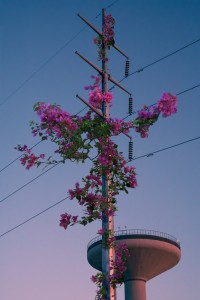Amina El-Edroos’s ‘The Neighbourhood’, comprising of 16 photographs printed on lustre paper, is the artist’s first solo exhibition. Wide whitewashed w
Amina El-Edroos’s ‘The Neighbourhood’, comprising of 16 photographs printed on lustre paper, is the artist’s first solo exhibition. Wide whitewashed walls of 8 B 2, Islamabad’s newest art gallery are the perfect backdrop for her emotive images; some candidly presented moments while others offering boosted effect through pixilation, double exposure, and manipulation. With ample natural light coming through the gallery windows falling on the frames, some as large as 24×36 inches and some more intimate at about 12×16 inches, each frame has its own arresting impact. Vivid blue and pink skies, a solitary cumulus cloud, concrete plain walls, ordinary electric poles, bored pigeons resting or mid-flight, and the banal bougainvillea creepers – all suggestive of a paradoxical nature of time – meaningless yet profound.
Amina El-Edroos is an artist, photographer and art educator. A graduate with distinction from Beaconhouse National University, she is currently teaching at National College of Art, Rawalpindi. The initial seeds for ‘The Neighbourhood’ were sown way back in 2013 when she presented her final thesis, primarily comprising of video works. ‘One of a 2-channel video projection was an aerial view of houses – over three hundred houses – which were all very similar. Each house was superimposed with little videos that showed very mundane acts being carried out such as eating or cleaning or picking up dishes. It was site specific installation. It was 31 feet by 9 feet. It was the time when I moved with my parents to a new suburban neighbourhood where everything was plotted along a grid,’ the artist shares. Suburbia and its monotony gradually started speaking to El-Edroos as she let go of the hustle and bustle of Lahore for a more calm and quiet neighbourhood of the capital. She kept documenting her surroundings as her own life transitioned through marriage and motherhood though all the while living in the same area.
Throughout these years of living in this suburban neighbourhood, Edroos kept collecting images from around her, selection of which can be seen at the exhibition and many more on her Instagram account. These poignant images represent the transitionality of life in a developing suburban neighbourhood in all their honesty – carving an identity without letting go of a stubborn diffidence – minimalistic landscape in which every new real estate development project can trace its identity or lack thereof. El-Edroos’s keen observation of this new urban mood reflects best in her frames ‘Urban Sculpture 1’ and ‘Urban Sculpture 2’, each with a lone street light pole quietly standing against a vivid evening sky. In ‘Urban Mesh’ we see these light poles and electricity pylons defying dimensions and directions as they enter the frame from all sides and still remain still and reticent. Through her art, one can almost hear the muted monotony of that exact same moment, evening after evening, just before the lights come on and the sky turns dark.
‘My medium for this show is photography which inherently also exposes me as a documenter of these images. While making contemporary art an artist must express within a conceptual framework and I feel that these images are all reflective of my own experiences of my surroundings. Of course the viewers do bring in their own perspectives but as artist one must also have the realization of what one is saying through his or her art. I like to talk about mundane a lot. Living in these emerging settlements and neighbourhoods, getting more and more immersed in our virtual preoccupations, our relationship with these tangible spaces around us are getting impacted. We are actually getting displaced away from the real and this should worry us,’ Edroos reflects.
Often written off as uninteresting, suburbia is the new cityscape that most of us find ourselves spending most part of our day in. The liminal spaces are what majority of us will call our neighbourhoods as cities expand. These new neighbourhoods may seem detached and impersonal but only if we don’t care to stop and observe; because if we do, we can find so much more to cherish, just as El-Edroos has done through her art. After all, time and by extension life itself, is meaningful only if we care to stop and look.

COMMENTS